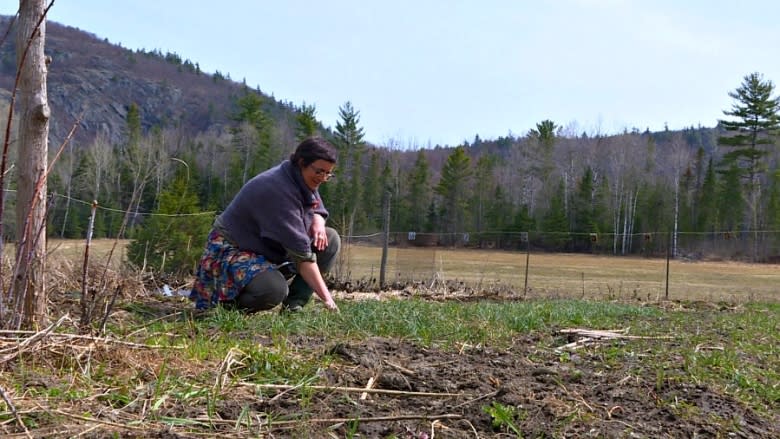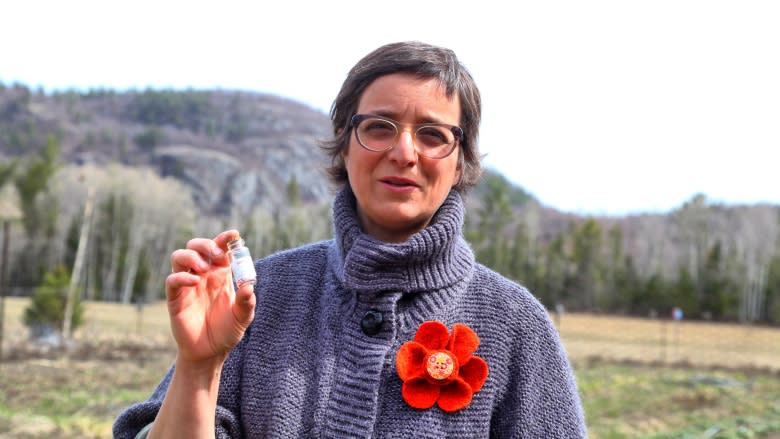Golden harvest no get-rich-quick scheme for Wakefield woman
Danielle Schami is mining gold in her Wakefield flower garden, but she's not expecting to strike it rich.
Schami, a former public servant, started Franktown House Flowers five years ago.
The mother of two elementary school-age children already grows about a dozen different kinds of edible flowers, which she supplies to markets around the region. High-end restaurants in Ottawa routinely garnish their dishes with her snapdragons, gem marigolds, nasturtium and anise hyssop.
As an experiment last year, Schami planted about 500 bulbs, or "corms," of the Crocus sativus, the flower that produces saffron.
"The truth is it's not that difficult to grow saffron, however we don't have the ideal conditions here and I'm a little bit stubborn so I really wanted to try it," said Schami at her 28-hectare property outside Wakefield, Que.
"It worked."
The successful harvest turned Schami into the region's only saffron producer and, she believes, one of only a few in Canada. This fall, Schami is hoping to triple her harvest of the delicate, Eastern flavouring.
"This is a gamble, but it's also a dream come true, really. I've been wanting to do this for over 20 years," she said.
Subtle, floral flavour
The ancient Greeks used saffron as a vivid yellow dye. Doctors to the Pharaohs prescribed it for stomach aches. Buddhist and Hindu monks relied on the luminous golden dye to colour their robes.
Today most saffron is used as a culinary ingredient, where it can add a subtle honey or floral flavour and a vivid golden colour to dishes such as paella or risotto.
The exotic yellow spice comes from the the bright red filaments that make up the pistil at the centre of the crocus.
The purple flower has a backward vegetation cycle, lying dormant all summer before blossoming just before the winter's first snowfall.
"What's wonderful for us as a flower farm, when our cut flowers are done because of the frost, up comes our crocus," said Schami.
"It's like a bumper crop for us."
Painstaking process
The cultivation is labour-intense. From October to about early December, Schami patrols the crocus patch twice a day, using tweezers to pluck the red thread-like filaments from the centre of the flowers before the blooms open and allow dust contamination.
Those threads of saffron are then dried under high heat.
The plot must be hand-weeded assiduously to keep the flowers strong, and in the months before it flowers, the blades of a crocus so closely resemble blades of grass that only very experienced gardeners can safely tell them apart.
For all that hard work, it's a potentially lucrative venture. At $30 a gram — the same price as a gram of 18 karat gold — saffron is called the most expensive spice in the world.
But this is no get-rich-quick-scheme. Schami will plant about 2,000 crocus corms this summer with the aim of harvesting a grand total of just six grams of saffron, which she'll sell in one-quarter-gram amounts.
Most of her crop is already spoken for by Ottawa's top chefs, who'll be able to boast of flavouring their culinary creations with ultra-rare, locally grown saffron.
With buyers leery of a market saturated with fake, impure and diluted counterfeits, Schami hopes to at least meet local demand and build on her reputation.
"It's perceived as being expensive, but it's actually that it's precious," Schami said.




